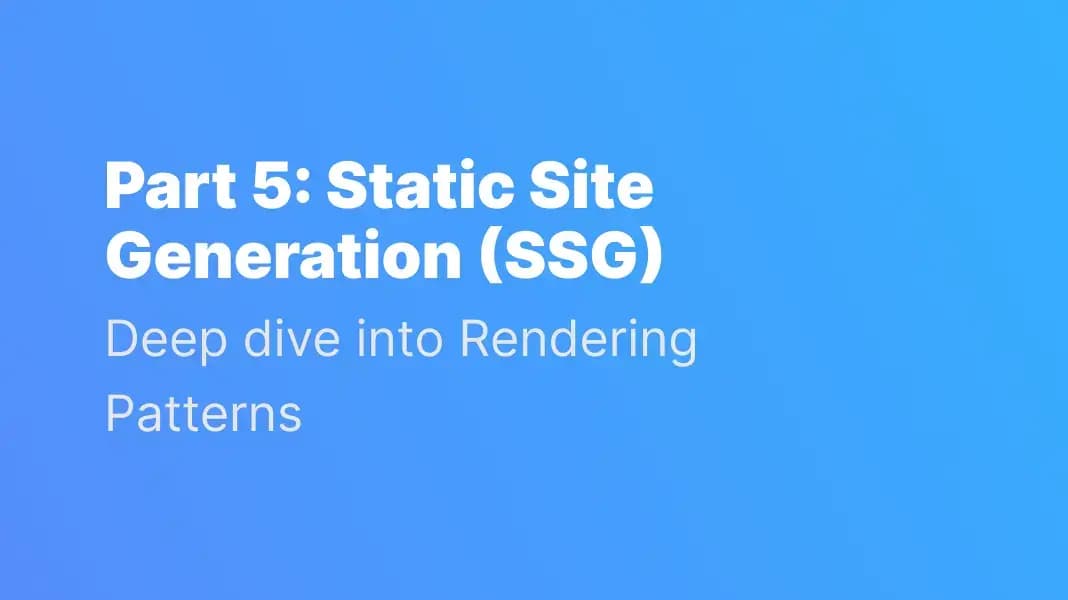user
Hey Chat, could you explain SSG with Hydration in simple terms, assuming I have no idea about rendering patterns? 🤔

Hamza Miloud amar
June 16, 2024
5 min read

In our last post, we covered Hydration. Today, we'll focus on Static Site Generation (SSG), a technique that pre-renders web pages at build time, resulting in fast and secure static files. SSG combines the best of both worlds by offering the performance of static sites with the ability to fetch dynamic content at build time.
Web Development Group
Me , Server , Browser, CDN, Narrator
user
Hey Chat, could you explain SSG with Hydration in simple terms, assuming I have no idea about rendering patterns? 🤔
narrator
Imagine you're hosting a big dinner party. You prepare all the dishes in advance and wait for the guests to arrive. Once they are seated, you quickly set the table and make everything look perfect so they can start enjoying the meal right away. 🍽️ This is like Static Site Generation (SSG) – the website content is pre-built and ready to go when users visit.
narrator
Then, after you serving the main dish, you bring out the sauces, drinks, and final touches to make the experience even better. This is like hydration – adding interactivity to the pre-built content, making it dynamic and responsive for the users.
user
Mmm, that sounds interesting! Could you explain a real world example, showing the step by step process of how the server and browser work together to make this happen? 🤔
server
My primary responsibility is to pre-render web pages as static HTML files during the build process. This ensures that pages are available for immediate delivery when requested by the browser.
browser
Once I receive the pre-rendered HTML, I display the initial page layout to the user. Then, I execute the JavaScript code, adding interactive elements and any additional content to create a dynamic user experience. 💻
user
Those sound like good reasons. What are the main advantages of using SSG with hydration? 👍
server
server
Blazing Fast: Like static websites, SSG with hydration loads incredibly quickly because the initial content is pre-generated. ⚡
server
Interactive: The hydration process adds JavaScript, making the site feel like an app with interactive features. ✨
server
Better Security: Less server-side code means fewer vulnerabilities for hackers to exploit. 🛡️
server
SEO Friendly: Search engines still love them because of their speed and simple structure. 🏆
cdn
And don't forget! I'm a caching whiz, making it super easy for me to cache your site and deliver it lightning-fast to your users, wherever they are. ⚡
user
Those are some impressive advantages! But are there any downsides? 👎
server
server
Limited Real-Time Features: SSG sites can handle simple interactions, but they may not be the best choice if you need features like live chats or real-time updates.
server
Build Time: Generating all those pages upfrontcan significantly slow down the build process, especially for very large sites.
server
Content Deployment: Updating content requires a new deployment of the site 🛠️.
user
I'm really liking this SSG with hydration concept! I'm curious, though, are there any potential performance issues I should be aware of?
browser
browser
If your website includes large files it may take longer to load, particularly on slower internet connections.
browser
Additionally, if there are a large number of pages that require pre-rendering, this process can also be time-consuming.
user
That makes sense. So, what can we address these performance issues 🛠️? ?
browser
There are several ways to optimize those files. We've already covered some of them here, and we'll delve into even more modern JavaScript optimization techniques, such as Progressive Hydration and Server Components, in a later section.
browser
Additionally, consider using Incremental Static Regeneration (ISR) to improve build times.
browser
Furthermore, techniques like Navigation Prefetching can be employed to pre-load links to other pages on your site, making navigation feel incredibly fast.
user
GOOD But I'm curious, which framework would you recommend for building a static site generator (SSG)?
server
Here are a few popular options: Gatsby | Next.js | Nuxt.js
user
Thank you for this insightful overview. I appreciate the clarity.
server
You're most welcome! 😊 If you're ready to take it to the next level, check out our upcoming post on Server-Side Rendering (SSR). It's like having a personal chef cook up a customized meal for each of your guests on the spot! 🧑🍳
me
Thanks for taking the time to read my article! I'd love to hear your feedback – any questions, suggestions, or different perspectives are welcome. Your input helps me improve and create even better content. Feel free to follow me and continue the conversation on 𝕏 to continue the discussion.
Thank you for joining us in exploring Static Site Generation. In our next post, we'll discuss Server-Side Rendering (SSR), a technique that renders web pages on the server at request time for a dynamic and personalized user experience. Goodbye for now, and see you in our next discussion on Server-Side Rendering!
Experienced Frontend Developer | Passionate about building elegant, accessible, and UX-friendly Design Systems with React | Skilled in React Next Remix | CSS enthusiast | Lover of Clean & Maintainable CSS | Always learning and growing.
Let's ConnectConnect With Me On Social Media
I appreciate your visit to my website. If you find my work interesting and would like to know more about me, please consider following me on social media. Thank you!
© 2025 Hamza Miloud Amar. All Rights Reserved
1302 Views